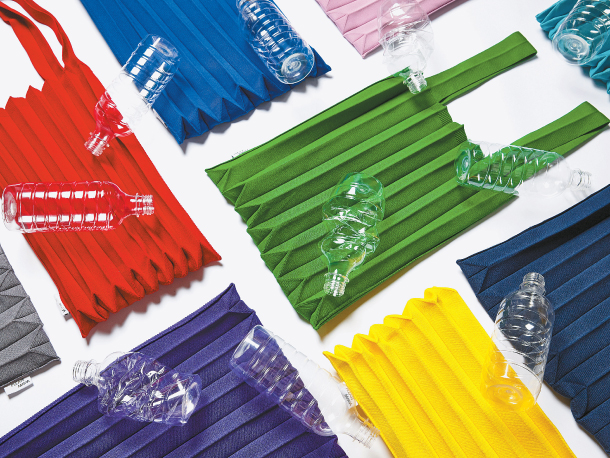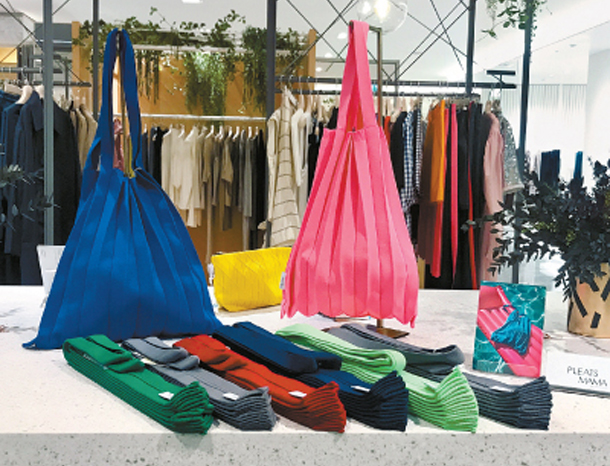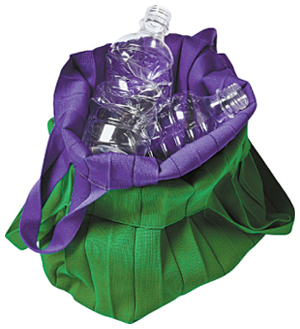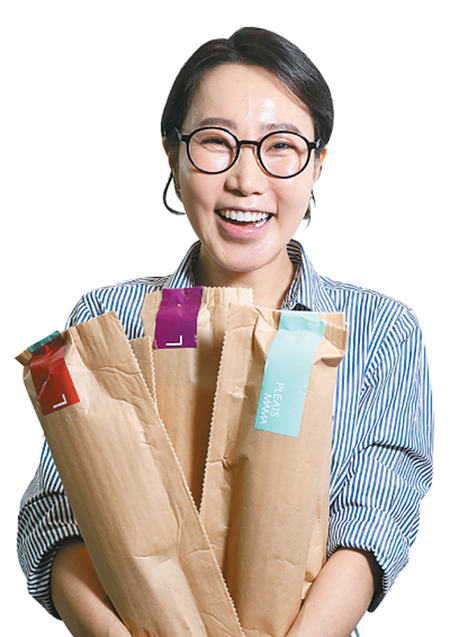Recycling in vogue as fashion goes green : Chic bags made from used plastic bottles are summer’s hottest trend

Knit bags from Pleatsmama are created using thread made from used plastic bottles. The thread is made using 16 different used 500-milliliter plastic bottles. [PLEATSMAMA]
Since the bag was launched on July 2, big name department stores and major online and offline shops have been flooded with calls from people hoping to get their hands on it. Many in the lifestyle industry have said that “anti-plastic” may be the trend of the year, with more and more people considering their consumption habits in conjunction with the plastic cup ban that went into effect this month.
Pleatsmama has sold over 4,000 bags at Hyundai Department Store branches across the country and its items made in collaboration with local brand Bean Pole have completely sold out.
Wang Jong-mi, president of Pleatsmama recently sat with JoongAng Sunday, an affiliate of the Korea JoongAng Daily, to discuss the recent influx of brands making upcycled and recycled products.
The following are edited excerpts from the interview.

Pleatsmama products are on display at Hyundai Department Store a week after its official launch. [PLEATSMAMA]
A. I worked as a designer at a company that was an original equipment manufacturer of knit products. The company closed its doors last year, and there was seven tons of thread left at the factory, which was worth about 600 million won ($530,000). I asked the president why and what I was told was that it costs money to throw the leftover thread away. When I heard that, I couldn’t help but sigh. But, I also started to think that I should do something with recycling.
The experience I had while making knit products probably helped me [develop the idea]. Making clothing or bags leaves pieces of fabric that cannot be used and are thrown away, but knits are different. One can just unravel them and make something else, so there’s nothing to throw away. It was the perfect way to make something environmentally-friendly.
Were you concerned about the fact that there are many brands selling recycled products?
When you think about recycled or upcycled clothing and accessories, they are usually considered unfashionable. Also, they are often made in small quantities, so the prices are higher than the consumers can afford. In these cases, there are limitations in the way of a brand being able to become popular and grow. Freitag [Swiss brand that makes bags with recycled materials] is often mentioned as the only successful upcycling brand that people know about [because they have been able to grow.]
What was your plan to make the business work?
First of all, it was important to figure out whether I would be able to mass-produce items. I focused on the economy of scale, so that I could lower prices as I sold more. The first thing I needed to make sure of was if I was able to get a consistent amount of recycled materials. I was asking around and I learned that Hyosung TNC has made polyester thread from used plastic bottles for about 10 years. I called the company right away and asked about the thread and they were thrilled.

The bags can be layered to show different colors at the same time. [PLEATSMAMA]
I learned about this later, but this recycled thread is a material that major global brands like Nike, Patagonia and H&M buy 10,000 tons of every year. Usually, hiking gear and shoes are made using the thread. There were some local companies that tried making products with the thread in 2013, but the products didn’t last long because the market reaction was very lukewarm. I suggested that I would be making a bag, and the company welcomed the idea. For Hyosung TNC, the product is something that it can show at conventions overseas, and for us, it is a steady source of materials we can work with.
Were you ever worried about the quality of the products because you were using recycled items?
The price of recycled thread is about 1.7 times more expensive than synthetic thread. However, there was no problem with quality at all. On the contrary, when I asked the factories, the recycled polyester has a better chance of getting colors right, and the thickness of thread is also more consistent. However, I do regret the fact that the threads are made from bottles imported from Japan. Plastic bottles in Korea usually have labels attached to them, leaving behind residue.
How did your product become available in department stores only a month after its launch?
That is all thanks to social media. Before the official launch in mid-June, I posted about the concept of the brand on Instagram and included photos of the products. After that, I was contacted by a buyer from Hyundai Department Store. I immediately signed a contract to have my products sold at two branches. About a week later, Queen MaMa Market [in Sinsa-dong, southern Seoul] contacted me asking if they could sell the bags as well. The very next day, my products were displayed in the shop. There are many requests coming in via direct messages on Instagram asking to sell my products in other shops, and some even ask if the bags can be borrowed for TV shows in the comments.
Do you think that your product happened to come at the right moment?
Yes, I was lucky. But that doesn’t mean that I didn’t have a strategy. It is an old school idea to talk about the “good intentions” your products have when you are selling environmentally-friendly items. I’m not an environmental activist, but I want to give an alternative to those who want to do good for the world. I think people who carry around their own tumblers do what they can because they want to do good for the world. I have suggested a way for people to [do something similar.] In fact, many people who have bought the bag use the hashtag [which translates to] “A bag made with 16 used plastic bottles.”

Pleatsmama’s CEO Wang Jong-mi holds her bags put in packages.
There are already copies of the bag being sold. It is made with synthetic thread and costs 10,000 won more than ours. However, what it can’t copy is the message we have. For example, our packaging is different. We wanted to find a wrap that doesn’t require multiple layers but still can keep the product safe. Then we found an ingredient a Japanese auto part maker uses to keep their products from being scratched at Bangsan Market in Seoul. The launch was a bit delayed even after the products were ready because of the wrap. This kind of effort that we put in can never be copied.
How do you plan to add more to the identity of the brand?
I learned a lot in a short period of time. I had confirmed that being environmentally friendly also means testing out ideas to see what works when they are combined together. The bag is the product of using textile technology that’s been around for over 100 years with the materials that were introduced about 10 years ago.
I’m now experimenting with other recycled materials. I don’t need to educate consumers - I just need to show what I have and communicate. Sometimes I get direct messages on Instagram from people who tell me that they are cheering me on and these are more precious than anything else.
BY LEE DO-EUN [summerlee@joongang.co.kr]
골칫덩이 플라스틱? 페트병 16개면 가방이 됩니다
올해 라이프스타일 분야의 핵심 키워드를 꼽으라면 단연 ‘안티 플라스틱(Anti Plastic)’이다. 폐비닐 사태, 해양 플라스틱 쓰레기 문제가 잇따라 불거지면서 별생각 없이 쓰던 플라스틱 소비 방식부터 바꿔야 한다는 흐름이 자리 잡은 것. 당장 이달 1일부터 테이크아웃 목적 외 매장 내 일회용 플라스틱 컵 제공은 금지됐고, 2020년까지 모든 생수와 음료수용 유색 페트병을 무색으로 단계적 전환하는 방안이 추진된다.
소비자도, 제조·유통 업체도 묵직한 과제를 떠안은 셈이지만, 이런 사회 분위기를 오히려 호재로 삼은 브랜드가 있다. 패션 스타트업 ‘플리츠마마(Pleatsmama)’다. ‘폐페트병(500㎖) 16개로 만든 가방’을 내세운 이 업체는 공식 론칭(7월 2일)을 한 지 불과 한 달 남짓 만에 시장의 뜨거운 반응을 얻고 있다. 백화점은 물론 국내 대표 온·오프 편집숍에서 러브콜을 보내왔고, 입점 이후 4000개 이상을 팔아치웠다. 또 빈폴 등 대기업 브랜드와의 협업 제품이 모두 소진되는 이변을 만들기도 했다. 이미 수많은 업사이클링·리사이클링 브랜드가 존재하는 가운데, 플리츠마마가 남달랐던 이유는 무엇일까. 지난달 25일 왕종미(39) 대표를 만나 이야기를 들어봤다.
재활용 소재, 효성티앤씨서 안정적 공급
리사이클링을 내세운 배경이 궁금하다.
응답 :“OEM(주문자 상표 부착 생산) 니트 제품을 만드는 회사에서 디자이너로 일했다. 지난해 그곳이 문을 닫게 됐는데 공장에 남은 원사가 부피로는 7t, 값으로는 6억원어치였다. 사장 말을 들어보니 버리는 데도 돈이 든다고 하더라. 그 이야기를 듣고 한숨이 나오면서 동시에 리사이클링을 제대로 해보자는 아이디어를 얻었다. 아마도 니트를 다룬 경력이 한몫했던 것 같다. 천을 잘라 만드는 옷이나 가방은 자투리 천을 버릴 수밖에 없지만, 니트는 다르다. 뜨개질처럼 뜨고 풀면 되지 버릴 게 없다. 친환경 제품을 만들기에 딱이었다.”
질의 : 업사이클·리사이클링 브랜드가 이미 많은데.
응답 :“업사이클링·리사이클링 패션 하면 뭔가 착하지만 촌스럽다는 이미지가 강하지 않나. 또 일일이 공을 들여 소량 생산을 하다 보니 가격이 소비자 눈높이보다 훨씬 높을 때도 있다. 이 경우 순수하게 브랜드로서 대중적 인기를 얻고 성장하기에는 한계가 있다. 결국 나중에는 원하는 메시지를 전하기도 힘들다. 지금도 업사이클링으로 성공한 브랜드 하면 ‘프라이탁’(버려진 천막을 재활용해 가방을 만드는 스위스 브랜드)밖에 꼽을 수 없는 것도 이런 이유다.”
그래서 어떻게 했나.
응답 :“일단 대량 생산을 할 수 있는가가 중요했다. 많이 파는 만큼 가격이 낮춰지는 규모의 경제를 목표로 삼은 거다. 재활용 소재를 안정적으로 공급받는 게 일순위였다. 맨땅에 헤딩 식으로 수소문하다가 효성티앤씨가 폐페트병에서 추출한 폴리에스테르 원사를 10년 전부터 만들고 있었다는 걸 알아냈다. 바로 회사에 전화를 걸어 문의했더니 적극적으로 호의를 보였다.”
질의 : 이제 막 시작하는 브랜드였을 뿐인데.
응답 :“나중에 알게됐지만 이 재생원사가 나이키·파타고니아·H&M 같은 글로벌 브랜드에서는 이미 연간 10만t씩 사가는 소재다. 주로 등산복이나 운동화 등을 만든다. 국내에서도 2013년부터 이 소재로 제품을 만든 몇몇 업체들이 있었는데, 매번 시장 반응이 별로라 단발로 끝났다고 하더라. 그러다 내가 이번엔 가방으로 만들어보겠다고 하니 반응이 좋았다. 효성티앤씨 입장에선 해외 박람회에 나가 보여줄 제품이 생기는 거고, 우리는 안정적인 공급처를 찾은 윈윈의 협업이었다.”
질의 : 재활용 소재라 품질이 걱정되지 않았나.
응답 :“가격이 합성 원사보다 1.7배쯤 비쌌다. 하지만 품질 면에서는 문제가 없었다. 오히려 공장에 물어보니 재활용 폴리에스테르가 일반 합성보다 발색도 좋고 섬유 굵기도 일정하다고 하더라. 다만 이런 재활용 소재에 대해 아쉬움이 들었다. 원사가 일본 페트병을 수입해서 만든 거였다. 한국 페트병은 라벨도 붙고, 잔여물도 많고, 색깔도 투명하지 않아 분리 배출을 해도 재활용이 쉽지 않기 때문이란다.”
카피 제품 팔리지만 메시지는 흉내 못내
론칭 한 달 만에 백화점까지 진출했다.
응답 :“순전히 소셜 미디어의 힘이다. 공식 론칭 전인 6월 중순쯤 인스타그램에 브랜드의 콘셉트와 제품 사진을 올렸더니 현대백화점 바이어가 연락이 왔다. 바로 두 지점에 입점 계약을 맺었다. 그러더니 한 주를 지나서는 편집숍 퀸마마마켓에서 연락이 와 바로 다음날부터 매장에 들어갔다. 경기도 용인에 있는 라이프스타일 매장인 동춘175에 입점할 땐 서로 바빠 얼굴도 안 보고 계약을 맺었다. 디엠으로 입점 문의가 오는 것은 물론이고 방송 협찬도 댓글로 물어온다.”
질의 : 특히 플라스틱 대란과 맞물려 타이밍이 좋았다.
응답 :“맞다. 운이 좋았다. 하지만 전략이 없었던 건 아니다. 친환경 패션이라고 해서 착하다는 것만 내세우는 건 옛날 이야기다. 환경 운동가는 아니지만 뭔가 세상을 이롭게 하고 싶다는 사람들에게 대안을 주고 싶었다. 카페에 텀블러 들고 오는 사람들도 딱 이런 마음 아닐까. 소비하면서도 도덕적 만족감을 줄 수 있는 방법을 제시한 거다. 실제로 산 사람들이 SNS에 올린 후기를 보면 ‘폐페트병 16개로 만든 가방’이라는 해시태그를 빼놓지 않는다.”
질의 : 다분히 이중적이다.
응답 :“물론이다. 우리 고객은 모순적이라고 당당하게 말한다. 옳고 그름을 떠나 이건 엄연한 패션 아닌가. 안목도 높지만, 개념도 있는 이들에게 둘 다 만족감을 줘야 한다.”
질의 : 친환경이라는 메시지는 좋지만, 디자인은 카피가 쉬워 보인다.
응답 :“이미 카피 제품이 팔리고 있다. 소재는 그냥 합성 소재인데 심지어 가격도 1만원 더 비싸다. 하지만 따라 할 수 없는 건 역시 우리의 메시지다. 가령 우리 제품의 포장지만 해도 그렇다. 사실 제품을 다 만들어 놓고도 론칭이 늦어진 게 이 포장지 때문이다. 과대 포장없이 제품을 한 번만 싸면서도 내부 손상이 없을 소재를 찾았기 때문이다. 그러다 일본 자동차 부품 회사가 스크래치를 막기 위해 쓰는 소재를 동대문 방산 시장에서 찾아냈다. 모양은 바게트처럼 단순하지만, 방습·방수·충격 보호가 다 된다. 이런 노력은 절대 카피할 수 없을 거다.”
질의 : 친환경 브랜드로서의 정체성을 어떻게 더해갈 것인가.
응답 :“짧은 기간 동안 배운 게 많다. 결국 친환경도 기존 것을 어떻게 재조합하는가의 아이디어 싸움이라는 걸 확인했다. 10년 전 나온 소재로 100년도 더 된 직조 기술을 합친 것 아니냐. 지금은 다른 재활용 소재를 찾아 실험 중이다. 또 친환경이라는 브랜딩도 그렇다. 굳이 소비자에게 가르치려 들지 말고 있는 그대로 보여주고 소통하면 될 뿐이다. 종종 디엠으로 ‘힘내라’는 메시지를 받곤 하는데 그 어떤 충성 고객보다 소중하다.”
이도은 기자










with the Korea JoongAng Daily
To write comments, please log in to one of the accounts.
Standards Board Policy (0/250자)